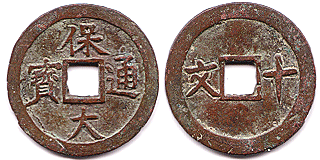Cast coinage on:
[Wikipedia]
[Google]
[Amazon]
 Cast coinage refers to
Cast coinage refers to
 Cast coinage refers to
Cast coinage refers to coin
A coin is a small object, usually round and flat, used primarily as a medium of exchange or legal tender. They are standardized in weight, and produced in large quantities at a mint in order to facilitate trade. They are most often issued by ...
s made by pouring melted metal into a mold, i.e. casting
Casting is a manufacturing process in which a liquid material is usually poured into a mold, which contains a hollow cavity of the desired shape, and then allowed to solidify. The solidified part is also known as a casting, which is ejected or ...
. It has been used for regular coins, particularly in East Asia, but also other areas on a smaller scale (e.g. the ancient Mediterranean world). The method differs from the current mode of coin production, which is done by striking coin blanks that have been cut out of metal sheets. The method has also been used by forgers.
Traditional Far Eastern cast coins—so-called 'cash
In economics, cash is money in the physical form of currency, such as banknotes and coins.
In book-keeping and financial accounting, cash is current assets comprising currency or currency equivalents that can be accessed immediately or near-i ...
coins'—are the most famous example of cast coinage, and were issued from the 4th century BC until , predominantly in bronze
Bronze is an alloy consisting primarily of copper, commonly with about 12–12.5% tin and often with the addition of other metals (including aluminium, manganese, nickel, or zinc) and sometimes non-metals (such as phosphorus) or metalloid ...
, brass
Brass is an alloy of copper and zinc, in proportions which can be varied to achieve different colours and mechanical, electrical, acoustic and chemical properties, but copper typically has the larger proportion, generally copper and zinc. I ...
or iron
Iron is a chemical element; it has symbol Fe () and atomic number 26. It is a metal that belongs to the first transition series and group 8 of the periodic table. It is, by mass, the most common element on Earth, forming much of Earth's o ...
. Traditional Far Eastern coins were generally cast base metal coins, although silver
Silver is a chemical element; it has Symbol (chemistry), symbol Ag () and atomic number 47. A soft, whitish-gray, lustrous transition metal, it exhibits the highest electrical conductivity, thermal conductivity, and reflectivity of any metal. ...
and gold
Gold is a chemical element; it has chemical symbol Au (from Latin ) and atomic number 79. In its pure form, it is a brightness, bright, slightly orange-yellow, dense, soft, malleable, and ductile metal. Chemically, gold is a transition metal ...
bars were also manufactured, e.g. Chinese sycee, Japanese obans and kobans, and Vietnamese lang and tien.
Cast potin
Potin is a base metal alloy used in coins. It is typically a mixture of copper, tin and lead (in varying proportions) and does not typically contain significant precious metals. Potin is usually used in reference to Celtic coinage.
In Celtic co ...
s circulated in Kent from around 100 BC to around 50 BC. At a point during the first century of the Christian era, cast bronze coins were produced in Dorset with archaeological evidence pointing towards Hengistbury Head
Hengistbury Head (), formerly also called Christchurch Head, is a headland jutting into the English Channel between Bournemouth and Mudeford in the English county of Dorset. It is a site of international importance in terms of its archaeolog ...
as the source.
By AD 200, cast copies of silver denarii were being produced in a number of areas of Britain. While these may have been straightforward forgeries the context in which some of the moulds have been found suggest there may have been at least some elements of semi officialdom.
References
Numismatics Currency production methods {{Coin-stub